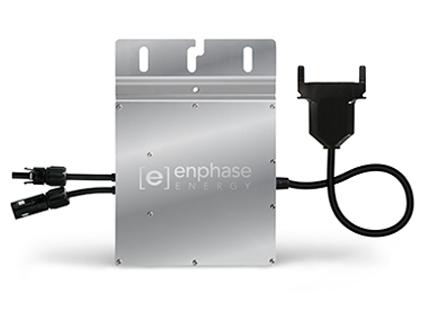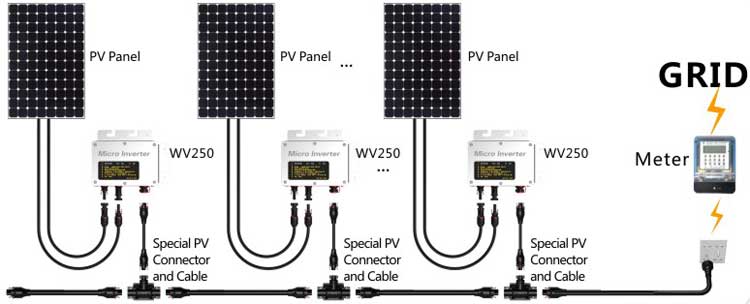This article discuss in detail why introduction of micro inverters are game changer for solar power industry.
Inverter: Inverters are used primarily to change direct current (DC) to alternating current (AC). An inverter converts a DC current to an AC current through a delicate electrical switching process. It functions like a synthesized alternator by creating a smooth alternation, similar to a pendulum gently swinging. This alternation takes the form of a sine wave, which is the ideal wave pattern for transmitting AC power.
String Inverter : Traditional string inverters dominated the solar market for quite some time. In a traditional solar power system with string inverters, interdependent strings of panels are placed together. If one panel gets obstructed by a bit of shade, bird poop or dust etc. the entire string of panels suffers, even if the other panels have no dust or shade problem. If one panel in a string has x% higher resistance due to manufacturing defect, the performance of string as a whole will degrade x%. A slight changes in orientation can cause mismatch in output. Solar power system with String Inverters is thus bulky, noisy, and most importantly, quite inefficient.
Micro Inverter : Micro-inverters are a relatively new technology. One Micro inverter is connected to each solar panel. It converts DC current from a single solar panel to AC current. The electric power from several micro-inverters is combined and fed into an electrical grid. It offers several advantages over conventional systems with string inverters, the main advantage being, even small amounts of shading, dust, snow or debris on any one solar panel, or a panel failure, does not disproportionately reduce the output of an entire array. Each micro-inverter obtains optimum power by performing maximum power point tracking for its connected panel, thus improving efficiency. Primary disadvantages of micro inverters are that they have a higher initial cost per peak watt than a central inverter, and secondly, as they are located near the panel, they may be harder to reach and maintain. But these problems are surpassed by their higher durability, efficiency and ease of installation.

ADVANTAGES of Micro Inverters
- Reliability : Micro Inverters increase reliability of solar power system as the failure of a single piece affects only that solar panel and not the whole solar array of solar panels in case of traditional Inverters.
- Increased Efficiency and Performance through MPPT : Maximum power point tracking (MPPT) is a technology where variables such as solar irradiation, ambient temperature, etc. are taken into account to ensure that a system yields maximum performance. A micro-inverter would perform MPPT on a system consisting of just one inverter and one solar panel, while a string inverter have to MPPT the whole solar array. If a single panel is operating at a different point, a string inverter can only see the overall change, and will move the MPPT point to match. Shading of as little as 9% of the entire surface array of a PV system can, in some circumstances, lead to a system-wide power loss of as much as 50%. Micro-inverter based systems yield 5-25 % increased power compared to systems using central inverters.
- Real time performance reports for each panel and inverter : Web-based monitoring on a panel-by-panel basis is available for both the users and the installers. Analyzing this information can be used to further improve performance and helps making sure that maintenance and repair is done when it should be. With some systems, you can even check the performance of your PV system on your mobile phone.
- Ease of Installation : Installing Solar Panels with Micro inverters is easier and faster and leads to lower installation costs compared to traditional Inverters. Installers are no longer limited by string design, marginal designs, co-planarity, and matched modules. Micro inverters reduce wiring time, and remove the need for DC switching points.
- Longer life : Micro inverters usually come with a warranty of 10-25 years. The Mean Life of micro inverters is more than the life of the traditional String Inverters, which have to be replaced every 5-10 years.
- Flexibility : One of the major benefit of micro inverter is its flexibility and scalability. One can start with a minimal set of solar modules and add modules as needs and budgets grow without requiring the replacement of a large centralized inverter. For example, if you want to build a 10 kWh solar panel installation for your home, you can start with a simple 120 or 240 watt solar panel, set it up with its own micro inverter. Then go on adding new solar panels, each one with its own micro inverter. You never have to worry about producing too little, or too much, for a large conventional inverter when you use micro inverters.
- Cost Effective : Cost savings using micro inverters is manifold. 1) Micro inverters individually are less expensive than a conventional inverter. When a conventional inverter fails, it is expensive to replace. Micro inverters, should they fail, are far less expensive to replace. 2) Micro inverters are far less likely to fail because of the smaller amount of electricity they must process when compared to a conventional inverter. and 3) Because of the limited range of power rated inverters available,solar panels have to generally use power inverters of greater size for e.g. 800 W of Solar Panels will have to use 1 KW solar inverters wasting the 200 W.
- Elimination of Space and Heat problems of String Inverters : String Inverters occupy more space, though not really big, and generate a lot of heat which has to be cooled by used fans.
- Decreased shock hazard : In a traditional String / central inverter, DC bus voltage is as high as 600V DC to 1000V DC. This creates high personal injury risk. With a micro inverter, it becomes an AC module system, and the installers crew or the maintenance personnel are not exposed to high voltage DC.
- Maintenance without major Service Interruption : While installing the system or performing maintenance on an existing system, one must de-energize the AC distribution in traditional DC system with string inverters. This results in service interruption. While using micro inverters, you don't need to shutdown your energy generation for the rest of the panels. So there is no major service interruptions.
- Fire prevention and arc faults : Arc faults are a major cause of PV fires, which are both dangerous and expensive. Unlike DC-based systems, AC systems are less likely to sustain arcs for two reasons. First, the current passes through zero twice per cycle. Second, the internal DC voltage is only that of a single PV module instead of multiple modules. An AC module system may also help prevent fires in the first place because the micro inverter can detect an abnormality in the grid voltage and shut off the PV power automatically.
- Rescue worker safety : In case of fire, firefighters first shut off the power to protect workers and prevent the fire from spreading. However, in the case of a DC system, shutting off power with the circuit breakers only shuts off the central inverter, not the DC voltage generated from the panel. As a result, firefighters may hesitate to spray water, as it can actually make a PV fire worse. Second, firefighters risk their life with live wires when cutting through the walls or roof. Due to these concerns, they may let the building burn in a controlled manner rather than try to extinguish the fire. In AC modules, AC output is cut off by opening a circuit breaker, as mandated by codes and standards. This eliminates all live electricity from the output of the AC module and greatly reduces shock hazard during installation and maintenance. More over, unlike AC modules, conventional DC modules do not inherently have a shut-off switch.
Major Drawbacks of Micro inverters compared to String Inverters
- Cost : Traditional Inverters cost between 35-50c/watt depending on the size, technology, brand etc. while micro-inverters typically cost between 50-75c/watt again depending on brand, market etc. This is the single biggest disadvantage of micro inverter compared to string inverters. The reason for this is that a micro-inverter has to duplicate large parts of a central inverter.
- Placement of Micro-inverters : Micro inverters are placed individually to the rack below each panel. This is said to cause problems as it is placed on the hottest part of the solar system and could lead to problems in case of high insolation areas.
- Not ideal for large Utility systems : Generally, micro inverters are used for smaller size systems. Utility Solar Power Plants of more than 1 MW in size do not use micro inverters because it becomes difficult for maintenance crew to go great length to repair / change faulty micro inverter.
